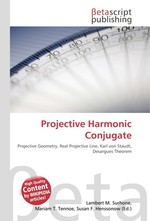Projective Harmonic Conjugate
Lambert M. Surhone, Mariam T. Tennoe, Susan F. Henssonow
бумажная книга
Please note that the content of this book primarily consists of articles available from Wikipedia or other free sources online. In projective geometry, the harmonic conjugate point of a triple of points on the real projective line is defined by the following construction due to Karl von Staudt: “Given three collinear points A, B, C, let L be a point not lying on their join and let any line through C meet LA, LB at M, N respectively. If AN and BM meet at K, and LK meets AB at D, then D is called the harmonic conjugate of C with respect to A, B.” (See Goodstein and Primrose (1953)). What is remarkable is that the point D does not depend on what point L is taken initially, nor upon what line through C is used to find M and N. This fact follows from Desargues theorem; it can also be defined in terms of the cross-ratio as (A, B; C, D) = –1. The four points are sometimes called a harmonic range on the real projective line. When this line is endowed with the ordinary metric interpretation via real numbers, then the projective tool of cross-ratio is in force.
Данное издание не является оригинальным. Книга печатается по технологии принт-он-деманд после получения заказа.


